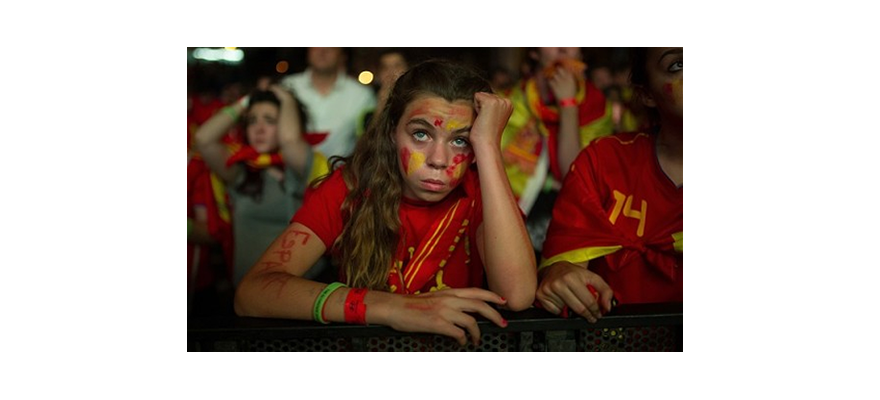Spain: the End of an Era by Solace Chukwu
When American referee Mark Geiger blew his whistle after ninety minutes on the 18th of June, it signalled the final knell for a group of legends. It was fitting that the most iconic of football venues, the Maracana, became the graveyard for a team that had defied change and wear. On that day, the Spanish national side saw the defence of its World Cup crown grind to an abrupt halt. The signs had been there for many to see. Only five days earlier, the world had watched on, incredulous as a young Dutch team destroyed them 5-1 in Salvador. In itself, that game showcased football’s capacity for unpredictability. Spain went a goal up inside half an hour, could have gone two up soon after, conceded an equaliser on the stroke of half time and fell apart in the second half.
A game of fine margins, football. Its low-scoring nature heightens the possibility of upsets, and so this was viewed. Upsets happen; surely this could not be the end of a team that had won the last three major international football tournaments. Perhaps this is what made a 2-0 loss more jarring than a 5-1. Whereas the Spanish had looked the better side for some part of the evisceration at the hands of the Netherlands, they never looked like having a go against Chile. A two-goal lead is notorious for its instability: does the leading team attack in search of more goals to secure the result; or defend to maintain the margin, with the knowledge that one goal from the opponent makes the game dicey again? Chile never had to worry about this. The defending World champions simply lacked the stamina for a fight. The siege never came. What followed was the global panning of the Spanish style of football. Reactionary proclamations such as the “Death of tiki-taka” were rife, but neglected a basic fact. A football style cannot die per se, much like fashion trends do not die. A style has no life in itself; it is quickened by those who employ it. So much like 60s fashion is rehashed and given a new breath of inspiration for the 21st century, a football style is only as ‘alive’ with the vivacity of its employer. The short passing style and emphasis on ball-retention that came to be known by the Spanish colloquialism ‘tiki-taka’ is not to blame for Spain’s fall, neither can it be entirely praised for their sweeping success to this point. There is a human element most vitally, and this is where it all fell down for La Furia Roja. In keeping faith with essentially the same group of players: the spine of Iker Casillas, Sergio Ramos, Xavi Hernandez, Andres Iniesta and David Villa, from 2008, coach Vicente del Bosque ensured the unity of a group and the locality of the short-passing style. Where there was change, it was enforced mainly by retirement (Jordi Alba for Joan Capdevila; Sergio Busquets for Marcos Senna for example), or injury (Gerard Pique for Carles Puyol). It is perhaps telling that this World Cup was the first time the notoriously loyal del Bosque truly went outside the group. In came naturalized Brazilian Diego Costa, much to the consternation of the locals, off the back of a prolific season with Spanish league champions Atletico Madrid. The fact that he was preferred to record Spanish national team goalscorer Villa and long-time del Bosque favourite Fernando Torres was telling. In came the fantastically named Cesar Azpilicueta in place of long-term right-back Alvaro Arbeloa, off the back of an admittedly promising club campaign filling in at left-back. This represented the highest turn-over not precipitated by injury or retirement between major tournaments for Spain over the past six years. While there is a case to be made that the new players had been impressive for their clubsides in the prior twelve months, there is some truth to the cliché “Form is temporary, class is permanent”. A World Cup comes around once in four years, so why should the premier consideration for a squad place be the performance over a season? If a player scores 30 goals in the club season immediately preceding the World Cup, and another has accumulated a steady return of 15 goals a season over the four-year interregnum, which should rightly be selected for the World Cup? This is perhaps a strange case of football not justifying a cliché it holds to be universally true. While it is fair to say that this Spain side was getting slightly over-the-hill, a first-round exit surely hints at other issues. Ultimately, the changes unbalanced the team: Costa is a forward who thrives in a direct playing style, not a short-passing one, while Azpilicueta is a steady but defensive full-back. They will be remembered as one of the greatest international sides, and certainly no other matched their achievements. There is a new generation waiting in the wings, but it remains to be seen how much the inevitable sweeping changes will unbalance a team that defined an era and dominated it like no other. Image source





